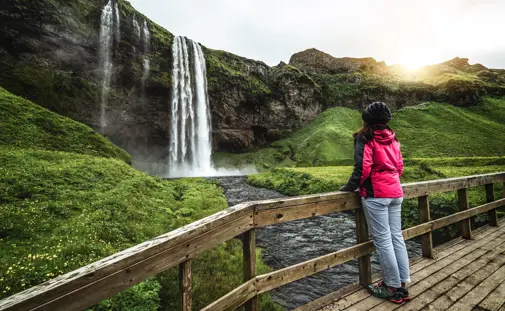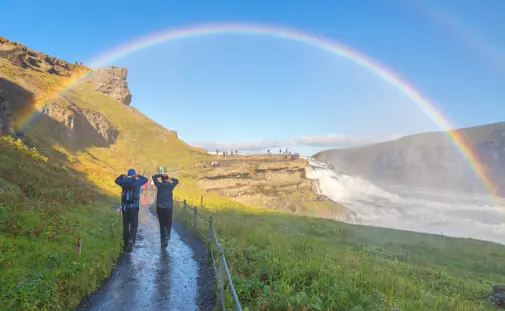Glaumbær Turf Houses
Glaumbær Museum is a historic turf farm located in Skagafjörður, North Iceland, offering visitors a fascinating glimpse into traditional Icelandic life from the 18th and 19th centuries. The museum is housed in a well-preserved cluster of turf buildings, which were once a typical form of rural Icelandic architecture, designed to withstand the harsh climate. The turf houses, with their thick grass-covered walls and wooden interiors, provide insight into how Icelanders lived and worked in the past, using the natural materials available to them.
The main building, Glaumbær, has been a farmstead since the Viking Age, with the current structures dating back to the mid-18th century. Visitors can explore the various rooms of the farm, including the living quarters, kitchen, and storage areas, all furnished with period artifacts that illustrate the daily life of Icelandic farmers. The museum also features exhibitions on local history, culture, and the development of Icelandic agriculture.
History of the Turf Farm
Farm Glaumbær dates to the 11th century, but the present buildings are from the 18th and 19th centuries. The museum complex comprises a number of turf houses and outbuildings that were once a traditional dwelling for many Icelanders up until late in the 19th century. The thick, insulated walls of these turf houses helped protect the inhabitants from Iceland’s harsh climate, and the design is a reflection of how people used the natural resources available to them. Glaumbær remained inhabited until 1947, when it was made into a museum, thus preserving its history for future generations.
Step into Iceland’s Past
Visitors to the Glaumbær Museum are transported back in time as they walk through the preserved turf houses and other exhibits in the museum. Original antiques and the reconstructions of rooms are combined at the museum as a means for insight into rural living in Iceland. Walking through the museum, people can experience the traditional Icelandic manner of living-small and interlocking rooms with low ceilings and thick turf walls to insulate against extremely harsh winters.
There are three main buildings to see at Glaumbær:
Glaumbær Old Turf Farm: This old turf farm is the centerpiece of the museum and is made up of many rooms that, in their time, were living quarters, storerooms, and workrooms. Each of the rooms has a story to tell, with items such as old furniture, household tools, and farming implements showing life as it was for people living in this area.
Gilsstofa: This timber-framed house is more modern than the classic turf farm and contains elements representing more modern eras in Icelandic history. Built during the 19th century, Gilsstofa gives further insight into how architecture began to change along with the availability of new materials and technologies. Inside, you will have exhibitions of local history, folk tales, and Iceland's cultural heritage.
Áshús: Áshús, another building within the Glaumbær site, deals with a somewhat later period in Icelandic history, especially from the early 20th century onwards. The building houses exhibitions on the daily life of Icelanders during that time, with artifacts and displays telling the story of how Icelanders adapted to modernization.
Each building possesses its specific collection of historic artifacts that, together, all provide a multidimensional view into the Icelandic rural past.
Map of Glaumbær Museum
The map of Glaumbær Museum includes the locations of all museum buildings, the church and parking and how to get to the turf house museum from Reykjavík.
Location & How to Get There
The Glaumbær Museum is located in Skagafjörður, in North Iceland, approximately 120 km northwest of Akureyri. The drive from Akureyri takes around 1 hour and 30 minutes via Route 1 and then Route 75. From Reykjavík, Glaumbær is about 330 km away, which is roughly a 4-hour drive. The museum is easily accessible by car, and there is ample parking available on-site for visitors.
-
GPS Coordinates: 65°36'37.7"N 19°30'15.7"W
Parking and Facilities
A car park has been made available next to the museum in Glaumbær, easily accessible from the entrance. The parking is free of charge, with ample space to park cars and tour buses. Simple on-site facilities include restrooms and a small coffee area where visitors can sit down and take a break with refreshments. In the summer months, the museum offers guided tours, which are a great way to delve deeper into Icelandic history and the significance of the turf farm.
Folklore
The story of Miklabæjar-Sólveig is a haunting Icelandic tale centered around a young woman named Sólveig who worked as a servant at the Miklabær farm manor in Blönduhlíð for Reverend Oddur Gíslason. Sólveig fell deeply in love with the priest, but her love was unrequited. He married in 1777, leaving Sólveig so heartbroken that she took her own life in 1778. Her dying wish, communicated to the farmhand Þorsteinn, was to be buried in the cemetery.
After her death, the local priest refused to bury her in consecrated ground due to her suicide. Her body was buried outside the church cemetery instead, and left unmarked. However, Sólveig’s restless spirit began haunting the area, and strange, unsettling events were reported by those who lived on the farm. She appeared to Oddur Gíslason in a dream threatening him to suffer the same fate as her as he could not grant her wish of being buried in holy ground.
Because of these strange events and threats to Oddur, the reverend was never to be left alone and was accompanied by two men at all times. However, in 1786, eight years after Sólveig’s death Oddur vanished and his body never found to be properly buried in consecrated ground.
So what does this story have to do with Glaumbær?
About one hundred and sixty years later, in 1937, Sólveig finally got her wish and was buried in the Glaumbær cemetery. Since her suicide Sólveig had worked relentlessly on getting her dying wish granted and was a frequent guest in both peoples dreams and at psychic meetings. Even reverend Oddur Gíslason had appeared to local farmers asking for her grave to be moved within the cemetery walls. In June 1937 her bones were found half buried under the cemetery walls. The priest of Miklabær had agreed to a small ceremony at the church but refused to bury her at Miklabær cemetery. After the funeral at Miklabær her coffin was taken to Glaumbær where a group of locals paid their respects and finally laid Sólveig to rest.
A single photograph remains of the six local farmers who carried Sólveig’s coffin to her resting place in Glaumbær on June 11th 1937.
Sources
Snerpa. (n.d.). Mikla sól og mikinn hita. Retrieved from https://www.snerpa.is/net/thjod/miklasol.htm
Glaumbær. (n.d.). Glaumbær. Retrieved from https://www.glaumbaer.is/is





